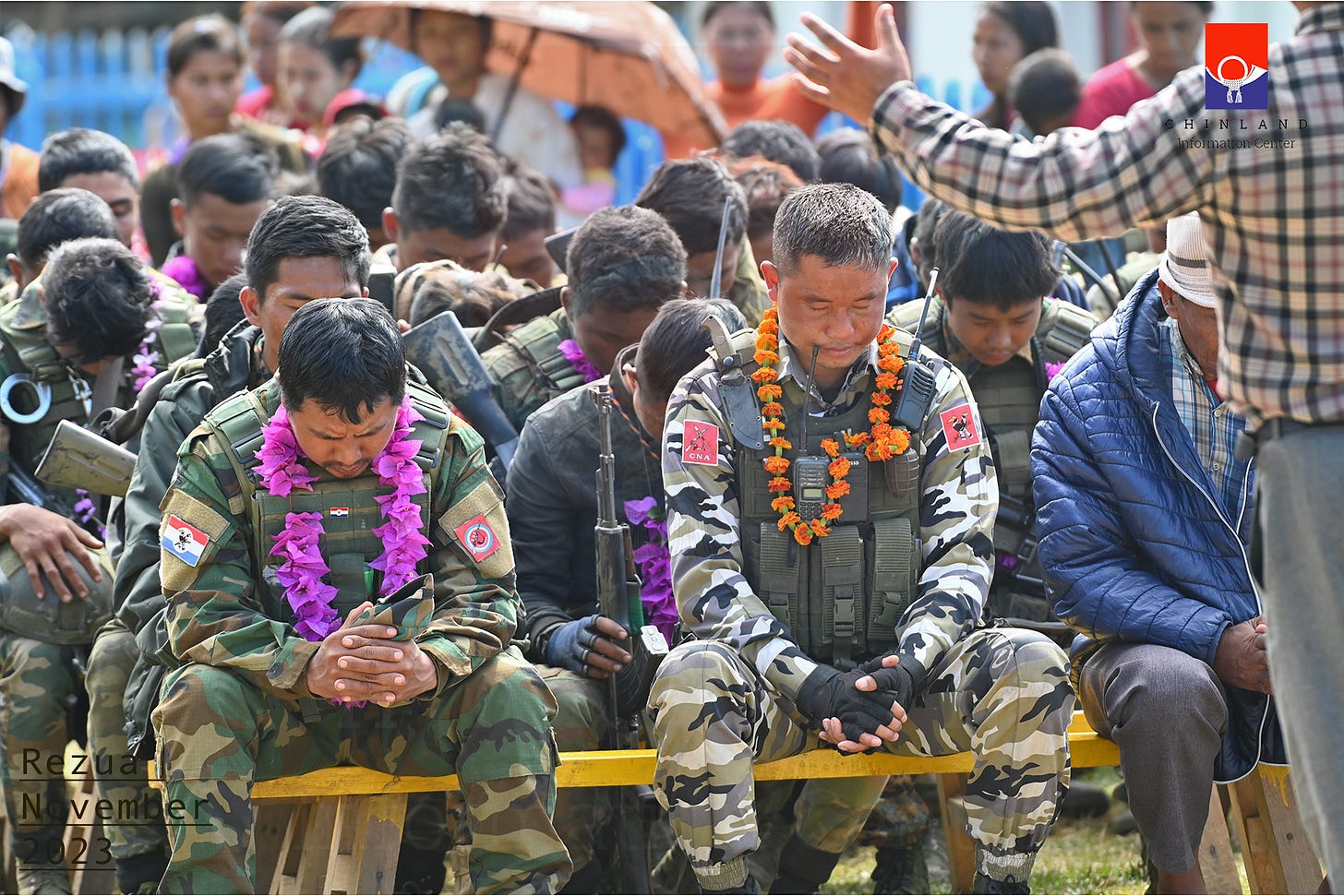The Chin split: A simple guide
Taking a look at the division in the Chin resistance and what it means for Myanmar's revolution.
Myanmar’s western edge: green mountains dotted with bold red blossoms, home to the Chin people. These devout Christians share deep ties with their ethnic cousins across the Indian and Bangladeshi borders – ties that have proved vital during the current uprising, with the northeast Indian state of Mizoram sheltering Chin refugees, just as Chin State once sheltered Mizo refugees in the 1960s.
In April 2021, armed with hunting rifles, the Chin launched the first major battle of Myanmar’s revolution. That was in Mindat town, which has since been liberated. Now they’ve upgraded to assault rifles and grenade launchers, pushing the military out of most of their territory.
But victory has brought a new challenge: a schism in the resistance that threatens to tear apart Chin society and – worst case scenario – spark a new wave of bloodshed.

The two camps
The Chin resistance has split into two rival camps, and their division tells us a lot about the broader challenges facing Myanmar’s revolution. Think of it as a clash between the old guard and the new generation. Or a father-son drama.
In one corner stands the Chin National Front (CNF), formed in the 1988 uprising – experienced, cautious, a bit set in its ways. In the other, the Chin Brotherhood coalition (CB) – comprising six resistance groups, born after the 2021 Myanmar military coup; energetic, fledgling, determined to liberate the country asap.
When young Chin first rose against the military, many sought training from the CNF. But instead of joining the old guard, they formed their own township-based forces. Some of these would later become the CB.
What’s the dispute?
The dispute is about who gets to shape Chin State’s future and how power should be divided. The CNF wants to organize things by dialect groups, while the CB prefers the current township system. It might sound like a minor administrative detail, but it’s actually key to who gets how much influence.
The CB also doubts the CNF’s commitment to revolutionary change, pointing out that it was involved in peace talks with the military before the coup.
Beneath this lies a history of tensions between the Chin “tribes”. The Lai Chin, who dominate the CNF, are seen as representing the interests of Hakha, the state capital, while other ethno-linguistic Chin groups worry about being sidelined.
Enter a major disruptor: the Arakan Army (AA). With somewhere between 30,000 and 45,000 troops, it’s one of Myanmar’s most formidable forces and is close to controlling all of Rakhine State, just south of Chin.
The AA has thrown its weight behind the CB, providing military expertise and weapons that helped capture several Chin towns. The CNF sees this alliance as a threat to Chin autonomy, especially since the AA already controls Paletwa, a strategic township in southern Chin that’s crucial for dealing with India. Frankly, the CNF’s also concerned because AA’s backing has turned the CB into a serious military competitor.
The CNF says: “Trust our experience. We’ll ensure all Chin groups are fairly represented. We should be the sole armed force of Chin State, and we’ll guarantee stability. Chin is for the Chin, not the AA. Support from the AA helps you, but at what cost to Chin State?”
The CB responds: “Hang on. We’ve been doing the heavy lifting – we’ve had the biggest military successes. Why should we trust you when you’ve negotiated and compromised with the military before the coup? Why should you be the dominant power?”
The price of division
Currently, both sides control their own territories, occasionally clashing violently. This split has real consequences: if united, the Chin resistance could be pushing into the lowlands and targeting the military’s crucial air bases.
Right now, they’re caught in a power struggle that’s turning into a race for battlefield victories to gain leverage in future negotiations.
The Chin people, already struggling with shortages of food, medicine, and education, stand to lose the most from this division. Neither side is likely to win a civil war within a civil war, yet neither seems ready to compromise.
Why this matters
This split reflects a challenge facing anti-junta opposition across Myanmar: how to balance the caution and interests of veteran ethnic armies with the energy of a new generation.
But it’s also a warning about how victory can sometimes lead to new conflicts, as groups that united against the junta begin fighting over the future they’re trying to build. Still, there is time and space for each side to compromise, and efforts are underway to assist this.
The interview
Made it this far? You’re officially a Myanmar watcher 😎. Below, I’m sharing an unfiltered interview with CNF vice chairman Dr Sui Khar. He mentions the Chinland Council, a CNF-led body that seeks to form a post-coup Chin government.
Originally published in Frontier, here’s the complete, unabridged version, exclusively for On Myanmar paid subscribers.
(A note for Myanmar readers: If banking or fund restrictions prevent you from subscribing, email me at lorcan.lovett@gmail.com)
In this version, the leader tackles some more big issues, including more on the CNF’s military plans and Chin infighting as well as CNF relations with the National Unity Government.



